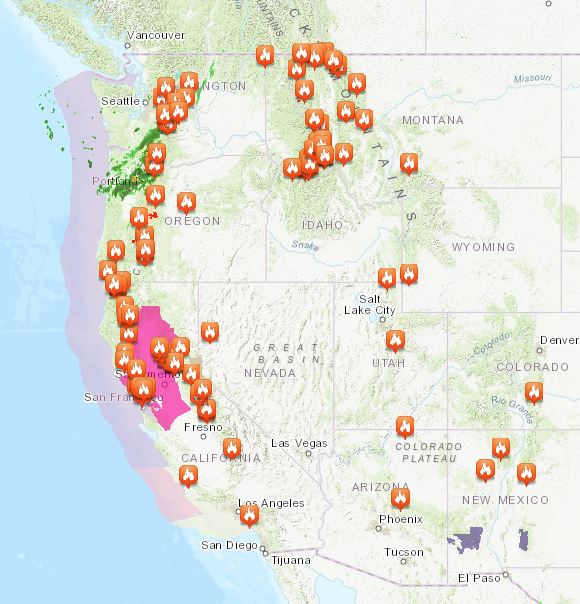2024 U.S. Wildfire Season: Predictions and Outlook
As we approach the 2024 U.S. wildfire season, experts predict a challenging year ahead, albeit with fewer fires than the historical average. According to the latest AccuWeather wildfire report, the forecast suggests that between 4 and 6 million acres could be engulfed by flames, a stark contrast to the 2.7 million acres burned in 2023. Historical wildfire trends indicate that the potential for damage may be heightened, particularly in regions like Texas, where wildfire risks are classified as high to extreme. Meanwhile, California’s wildfire outlook appears more optimistic due to a wet winter, which may delay significant fire activity until later in the summer. With these predictions in mind, understanding the dynamics of the upcoming wildfire season is crucial for preparedness and mitigation efforts across the nation.
The 2024 wildfire season in the United States is shaping up to present unique challenges and opportunities for fire management and safety. With forecasts hinting at a less intense year compared to historical averages, yet still a serious concern, authorities are gearing up for what could be a demanding period. The AccuWeather wildfire predictions for 2024 highlight critical areas like the Texas Panhandle, where the risk of devastating blazes remains high. Conversely, the California landscape is expected to experience a delayed onset of wildfires thanks to previous weather patterns that have influenced moisture levels. By analyzing these regional fire risks and trends, stakeholders can better prepare for the complexities of wildfire management this year.
Overview of the 2024 U.S. Wildfire Season
The 2024 U.S. wildfire season is shaping up to be a significant event, with expectations of increased damage compared to last year. According to the AccuWeather wildfire report, the number of acres burned is projected to be between 4 and 6 million, which, while concerning, remains below the historical average of approximately 7 million acres. This forecast reflects a trend where, despite potential increases in wildfire severity, the overall number of fires may not spike dramatically. Historical wildfire trends suggest a complex interplay of factors that contribute to the annual variations in fire activity.
In 2023, the U.S. experienced one of its least severe wildfire seasons in recent history, with only 2,693,910 acres scorched. This marked the fewest acres burned since 1998, indicating a potential downward trend in wildfire frequency. However, meteorologists are cautious about 2024, suggesting that environmental conditions, including stormy weather patterns, could influence wildfire risks and suppression efforts throughout the season.
Frequently Asked Questions
What are the wildfire predictions for the 2024 U.S. wildfire season?
The 2024 U.S. wildfire season is predicted to be more damaging than 2023 but still below the historical average. According to AccuWeather, between 4 and 6 million acres are expected to burn, which is less than the historical average of around 7 million acres.
How does AccuWeather’s wildfire report forecast the impact of weather on the 2024 U.S. wildfire season?
AccuWeather’s wildfire report indicates that stormy weather in the Northwest will likely suppress wildfires and the ability to conduct prescribed burns until later in the season. This is expected to keep fire risks lower in early summer.
What historical wildfire trends should we consider for the 2024 U.S. wildfire season?
Historical wildfire trends show that the U.S. wildfires burned only 2,693,910 acres in 2023, marking the lowest number since 1998. While 2024 is expected to be more severe, it is still projected to remain below historical averages.
What are the wildfire risks in Texas for the 2024 U.S. wildfire season?
The wildfire risks in Texas, particularly in the Panhandle, are predicted to be high to extreme in 2024, with significant fires already reported this year, including a grass fire that scorched over 1 million acres.
How does California’s wildfire outlook for 2024 compare to previous years?
California’s wildfire outlook for 2024 appears to be better than in previous years due to a wet and stormy winter, which is expected to delay significant wildfires until later in the summer.
What role does the annual monsoon play in wildfire predictions for the 2024 U.S. wildfire season?
The annual monsoon is anticipated to start slowly in 2024, with significant impacts expected in July and August. While it can help in battling wildfires through increased humidity, it can also trigger new fires due to lightning.
| Key Points |
|---|
| The 2024 U.S. wildfire season is projected to be more damaging than 2023 but still below historical averages. |
| Estimated acres burned in 2024 will range between 4 to 6 million, below the historical average of around 7 million acres. |
| In 2023, wildfires burned 2,693,910 acres, the fewest since 1998. |
| Stormy weather in the Northwest may suppress wildfires and prescribed burns in early summer. |
| California is expected to have limited wildfires due to a wet winter, with risks increasing later in the summer. |
| Texas Panhandle faces a high to extreme risk of significant wildfires in 2024. |
| The largest fire in 2024 so far has occurred in Texas, burning over 1 million acres. |
| The monsoon season will influence wildfire dynamics, with potential for both fire suppression and new ignitions. |
| The monsoon is expected to start slowly in 2024, intensifying in July and August. |
Summary
The 2024 U.S. wildfire season is anticipated to bring more challenges than the previous year, with predictions indicating that while the number of fires and acres burned may be lower than historical averages, significant risks remain. With a forecast of 4 to 6 million acres potentially affected, the season will be closely monitored, especially in high-risk areas like the Texas Panhandle. Factors such as weather patterns, including a wet winter in California and a delayed monsoon season, will play crucial roles in shaping the wildfire landscape. As we approach summer, it remains vital for communities to prepare for the potential impacts of wildfires and stay informed on evolving conditions.







